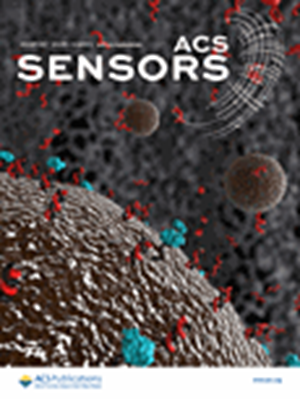基于蛋白质水凝胶空间限制策略制备的亚10nm s掺杂In2O3立方体用于ppb级二甲苯检测,并增强了电子转移能力。
IF 9.1
1区 化学
Q1 CHEMISTRY, ANALYTICAL
引用次数: 0
摘要
二甲苯传感材料的性能目前受到尺寸效应和电子轨道构型的限制。这项工作介绍了一种利用蛋白质水凝胶独特的结构特征和物理化学性质来创建空间受限域的合成策略。成功地制备了均匀分散在10 nm以下的s掺杂In2O3立方体,这是已知的最小的In2O3立方体。这些材料具有广泛的比表面积和高浓度的氧空位,实现了前所未有的二甲苯检测极限低至5 ppb。结果表明,空间限制域策略可以通过尺寸控制和非金属掺杂来调节材料的电子轨道,提高材料的吸附能力和电子转移能力。本文提出了利用水凝胶空间约束制备均匀高活性分散立方量子点材料的策略,并通过电子轨道调制提高二甲苯的传感性能,为先进传感材料的制备提供了新的途径。本文章由计算机程序翻译,如有差异,请以英文原文为准。
Sub-10 nm S-Doped In2O3 Cubes Prepared via a Protein Hydrogel Space-Confined Strategy for ppb-Level Xylene Detection with Enhanced Electron Transfer Capability.
The properties of xylene-sensing materials are currently limited by size effects and electronic orbital configurations. This work introduces a synthesis strategy utilizing the unique structural characteristics and physicochemical properties of protein hydrogels to create spatially confined domains. Uniformly dispersed sub-10 nm S-doped In2O3 cubes were successfully prepared, which are the smallest known In2O3 cubes. These materials boast an extensive specific surface area and a high concentration of oxygen vacancies, achieving an unprecedented xylene detection limit as low as 5 ppb. It was shown that the space-confined domain strategy can modulate the electronic orbitals of the material through size control and nonmetallic doping and enhance the adsorption capacity and electron transfer ability of the material. This work proposes a strategy to prepare homogeneous and highly active dispersed cubic quantum dot materials using hydrogel spatial confinement and enhances xylene sensing performance through electron orbital modulation, which provides a novel approach for the preparation of advanced sensing materials.
求助全文
通过发布文献求助,成功后即可免费获取论文全文。
去求助
来源期刊

ACS Sensors
Chemical Engineering-Bioengineering
CiteScore
14.50
自引率
3.40%
发文量
372
期刊介绍:
ACS Sensors is a peer-reviewed research journal that focuses on the dissemination of new and original knowledge in the field of sensor science, particularly those that selectively sense chemical or biological species or processes. The journal covers a broad range of topics, including but not limited to biosensors, chemical sensors, gas sensors, intracellular sensors, single molecule sensors, cell chips, and microfluidic devices. It aims to publish articles that address conceptual advances in sensing technology applicable to various types of analytes or application papers that report on the use of existing sensing concepts in new ways or for new analytes.
 求助内容:
求助内容: 应助结果提醒方式:
应助结果提醒方式:


